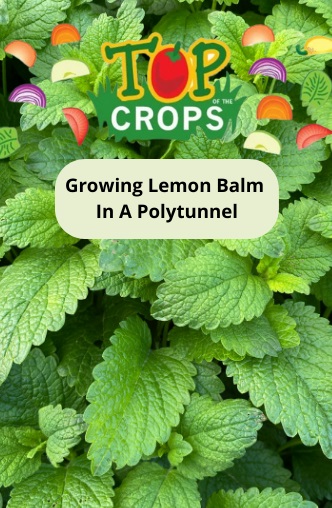The lemon-scented leaves of this bushy perennial will create a pleasant fragrance in your polytunnel. This herb is edible and medicinal and also serves as an excellent companion plant, drawing in pollinators and helping with pest control.
Lemon balm, Melissa officinalis, is a perennial herb that belongs to the mint plant family. Growing around 1m tall and spreading readily in the right location, this herb has leaves with a mild lemon scent and, in summer, bears pretty little white flowers that are attractive to bees and other pollinators.
Lemon balm, as a member of the mint family, is a good aromatic attractant plant for companion planting in a vegetable garden or around fruit trees. It also attracts bees and other pollinators making it a good choice for a wildlife-friendly garden.
Take care, however, as it can spread readily, and while self-seeding can sometimes be beneficial, you may wish to remove flowers before the plants set seed to prevent it from taking over your garden.
| Jan | Feb | Mar | Apr | May | Jun | Jul | Aug | Sep | Oct | Nov | Dec | |
| Sow |  |
 |
 |
|||||||||
| Plant |  |
 |
 |
|||||||||
| Harvest |  |
 |
 |
Lemon balm will do well in any well-drained soil and will grow happily in sun or partial shade. This herb can be grown in a bed or border in your polytunnel or outside, either in the ground where the soil is suitable, in a raised bed, or in a pot or container.
For one lemon balm plant, a 20cm pot will typically be sufficient in size, or you might choose a larger container and combine lemon balm with other herbs that like similar growing conditions.
When choosing where to grow lemon balm you should certainly think about how the lemon balm might be a good neighbour for a range of other plants.
Lemon balm is usually bought as a ready-grown plant in the spring, since when you purchase a plant you can select a variety, though generic lemon balm seeds are also readily available so they can also be grown from seed.
Seeds should be sown between March and May, into trays of compost, and covered with a thin layer of compost. They should then be placed into a propagator at a good and consistent temperature. Be aware that the seeds can take up to three weeks to germinate.
Plant your plants purchased online, from a garden centre or plant nursery, and plants you have grown from seed, into their own pots or containers as soon as they are large enough to handle, and into their final growing positions as soon as the weather has warmed sufficiently where you live and all danger of frost has passed.
Cuttings can be harvested during either spring or in the autumn. To successfully propagate from cuttings, it's a straightforward process of snipping a few inches from the soft tips of a well-established plant.
During springtime, you will take softwood cuttings a few inches below the tips of the fresh growth. Conversely, in the fall, opt for stems nearer to the base of the plant that haven't yet produced flowers.
To prepare the cuttings, remove approximately two-thirds of the leaves from the lower part of each stem, and gently pinch off the tips to prevent wilting.
Afterward, immerse the stems in rooting hormone or honey, then plant them in a sterile mixture consisting of equal parts coarse sand and planting mix to aid in moisture retention.
Ensure immediate watering of the cuttings and keep them away from direct sunlight. Typically, within three to four weeks, the plants should begin rooting. If desired, you can expedite this process by situating pots over a heating pad or in a heated propagator set to a temperature range of 721-23 degrees C..
Before transplanting the rooted cuttings outdoors, it's advisable to acclimate them to outdoor conditions by placing them in a well-lit and breezy area for about a week to harden them off.
If you grew your lemongrass from seed, they should be placed in a warm and sunny indoors spot once they have germinated. Then you should also harden off the indoors grown seedlings before you place them outside into their final growing positions.
Lemon balm is a good choice to grow in a pot, and you can either grow it on its own in a container, or combine it with other herbs. Depending on where you are placing it and the conditions to be found there, you might select either annual herbs or perennial ones as companions.
This is not a herb that needs a great deal of care and attention from a gardener. But there are some elements of care that you should be sure to think about to get the best results.
Water is of course one key thing to consider. Water in your plants well upon planting, and make sure that the plant is always well-watered throughout the summer months. Though more tolerant of dry conditions once established, this plant prefers consistently moist soil during establishment.
After flowering, it is a good idea to cut back your plants to encourage a new flush of leafy growth. Cutting back in early summer will also encourage ornamental, variegated varieties to put forth strongly-coloured growth.
You can rejuvenate congested clumps of lemon balm by lifting and dividing your plants in the autumn months. You can separate an existing clump into sections and replant those sections to grow on in a different part of your garden.
A polytunnel will aid lemon balm as inside a polytunnel they will not suffer from the excessive winter wet when can cause the roots to sit in waterlogged conditions and reduce the likelihood of rot setting in. In a polytunnel, lemon balm should be able to survive over the winter months and return to growth in the spring.
Lemon balm should be harvested between July and September and used fresh as required, or dried for later use throughout the year.
Considered something of a 'nurse plant' in a vegetable garden, lemon balm is often beneficial to crops growing close by. By drawing in bees and other pollinators it helps to ensure that pollination takes place for any insect-pollinated crops.
Lemon balm is also considered, as an aromatic herb to help repel, confuse or distract certain pest species. For example, it is said to play a role in keeping brassica or cabbage family pests at bay.
Lemon balm is not only a beneficial companion in a vegetable garden. It can also help in the same or similar ways when it is included in a fruit tree guild.
While many will simply plant seeds labelled as Melissa officinalis, there are some named cultivars that can be purchased here in the UK, including:
Melissa officinalis 'All Gold' – a variety with golden-yellow leaves.
Melissa officinalis subsp altissima – a variety with lime rather than lemon scented and flavoured leaves.
Melissa officinalis ' Aurea' – dark green leaves with heavy yellow splashing along leaf edges.
Melissa officinalis 'Compacta' – a compact variety of lemon balm.
Melissa officinalis 'Lemona' – a varietal with extra-high levels of essential oils.
Melissa officinalis 'Mandarina' – a variety that smells strongly of mandarins and is lower and more spreading than regular lemon balm.
Lemon balm can be used fresh or dried to make herbal teas or used to give a lemony-intensity to salads, sauces and a range of fish recipes. The leaves are best used fresh as a garnish rather than cooked. Dried leaves are also used in potpourris or drawer fresheners.
Lemon balm is often used in herbal medicine as a tonic, and it has been shown to help in the treatment of cold sores, and to inhibit an overactive thyroid. It is also used to treat insect bites and as an insect repellent. A tea made with the leaves is sometimes made, and the essential oil has a range of uses.
Lemon balm is typically resistant to pests and diseases, making it a resilient herb in the garden. Its natural properties include citronellal, a chemical compound known to deter various insects, thereby contributing to its pleasant lemon fragrance. While generally robust, there are still a few potential pests and diseases to remain vigilant against:
Among the most common pests that can trouble this plant are aphids and spider mites. In attracting these, however, lemon balm also attracts predatory insects that can help to keep their numbers down.
In overcrowded conditions with warm temperatures and quite high humidity, fungal infections of this kind may sometimes take hold. Maintain good ventilation when growing in a polytunnel to reduce the chances of this problem.
This is another fungal issue that may occasionally arise when growing lemon balm. This is also more common in warm and humid conditions and causes deep brown blotches on the leaves. Any leaves that are affected should be removed as soon as possible to prevent its spread.
Lemon balm can do well in a polytunnel because it can allow this herb to thrive throughout the winter months, when outdoors plants can struggle due to excessive winter wet and waterlogging can become an issue.
Remember, lemon balm also benefits other polytunnel plants, by drawing in beneficial insects while repelling, confusing or distracting some of those we do not want. So it can be a good choice as companion plant for a range of the food producing species you might grow.
